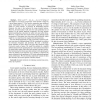Free Online Productivity Tools
i2Speak
i2Symbol
i2OCR
iTex2Img
iWeb2Print
iWeb2Shot
i2Type
iPdf2Split
iPdf2Merge
i2Bopomofo
i2Arabic
i2Style
i2Image
i2PDF
iLatex2Rtf
Sci2ools
FOCS
2009
IEEE
2009
IEEE
Space-Efficient Framework for Top-k String Retrieval Problems
Given a set D = {d1, d2, ..., dD} of D strings of total length n, our task is to report the "most relevant" strings for a given query pattern P. This involves somewhat more advanced query functionality than the usual pattern matching, as some notion of "most relevant" is involved. In information retrieval literature, this task is best achieved by using inverted indexes. However, inverted indexes work only for some predefined set of patterns. In the pattern matching community, the most popular pattern-matching data structures are suffix trees and suffix arrays. However, a typical suffix tree search involves going through all the occurrences of the pattern over the entire string collection, which might be a lot more than the required relevant documents. The first formal framework to study such kind of retrieval problems was given by Muthukrishnan [25]. He considered two metrics for relevance: frequency and proximity. He took a thresholdbased approach on these metrics ...
| Added | 16 Aug 2010 |
| Updated | 16 Aug 2010 |
| Type | Conference |
| Year | 2009 |
| Where | FOCS |
| Authors | Wing-Kai Hon, Rahul Shah, Jeffrey Scott Vitter |
Comments (0)

